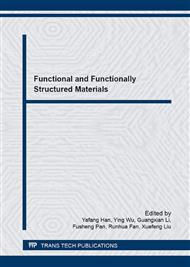p.3
p.9
p.13
p.18
p.23
p.28
p.32
p.38
p.43
Variation of Magnetoelectric Coefficient with Volume Fraction of Piezoelectric Phase in Pb(Mg1/3Nb2/3)O3-PbTiO3/FeCoV Laminate Composite
Abstract:
Soft magnetic material FeCoV is sensitive to magnetic field and its cost is lower than giant magnetostriction materials (Terfenol-D et al.). In the present investigation Pb (Mg1/3Nb2/3)O3-PbTiO3 (PMN-PT) with different thickness and FeCoV laminate with 0.8mm thickness were assembled into layer structure to study the effect of the PMN-PT volume fraction on the magnetoelectric coefficient of PMN-PT/FeCoV laminate composites. The ME coefficients and voltages have been characterized in the longitudinally magnetized and transversely polarized mode. The measurement was conducted under a static magnetic field superimposed with an alternating magnetic field. The influences of the static and the alternating field strength were discussed. The peak ME coefficient was obtained at 430 Oe. With the volume fraction of PMN-PT increased, the ME coefficient decreased within the experiment fraction. It can be explained by the module of M.I.Bichurin. A linear relationship was observed between the magnetoelectric voltage and the alternating field strength under a static field of 400 Oe. The ME voltage decreased when the PMN-PT volume fraction increased in the experiment fraction.
Info:
Periodical:
Pages:
23-27
Citation:
Online since:
March 2016
Authors:
Keywords:
Price:
Сopyright:
© 2016 Trans Tech Publications Ltd. All Rights Reserved
Share:
Citation:


